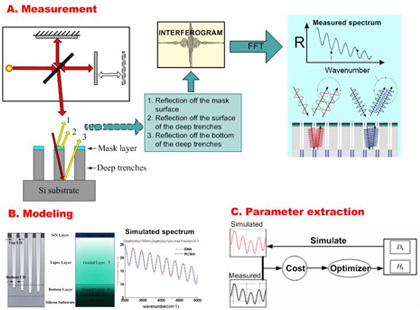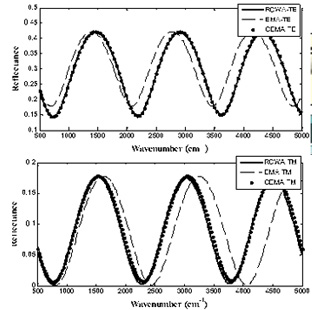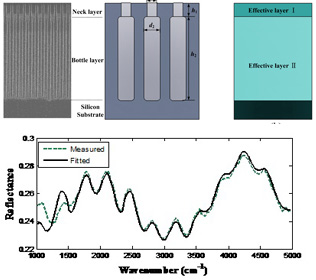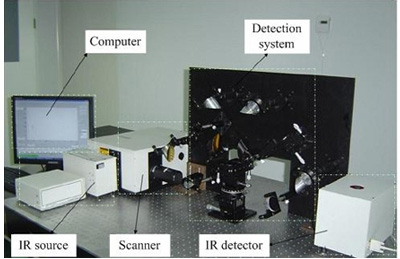Deep trench structures with high aspect-ratio have been widely used in microelectronics such as capacitors in advanced dynamic random access memory (DRAM) devices. As deep trench devices have been packed more tightly, the critical dimension (CD) and depth dependent features must now be monitored to ensure process control. Model-based infrared reflectrometry (MBIR) is an optical metrology that has been introduced recently for measuring high aspect-ratio periodic trench structures. The trench structure is modeled as a multilayer thin film stack with effective medium approximation (EMA) theory and the reflectance spectrum is measured in the mid-infrared wavelength range, from which the trench parameters are extracted by solving an inverse spectral problem. Therefore, the success of MBIR metrology relies heavily on accurate modeling of the trench structures and fast extraction of the trench parameters.
We have proposed a fast algorithm for reflectivity calculation of high aspect-ratio deep trench structures by an improved modeling method named corrected effective medium approximation (CEMA), which is based on EMA but a dispersion corrected term is added to calculate the refractive index of each effective medium. The CEMA method is demonstrated to be not only fast in calculation but also accurate enough in comparison with the rigorous coupled wave analysis (RCWA) for both 1-D and 2-D trench arrays.
We have also developed a method combining artificial neural network (ANN) and the local optimized Levenberg-Marquardt (LM) algorithm for fast extraction of geometric parameters from the measured reflectance spectrum, in which an initial estimate of the parameters is generated from the measured reflectance spectrum by ANN, and then the accurate result is obtained by the LM algorithm. The accuracy and robustness of the combined extracting method is demonstrated to be superior to ANN or LM optimized algorithm alone.
We have set up a MBIR platform to test the performance of the improved MBIR metrology. Using a bottle trench structure with square lattice of cylindrical trenches of high aspect-ratio as the specimen, we have achieved an acceptably overall result. In contrast with conventional techniques such as scanning electron microscope (SEM) and atomic force microscope (AFM), the MBIR metrology is noncontact, nondestructive, time effective, and of low cost. It is expected that this technique will have broad applications in on-line monitoring and process control for the fabrication of deep trench structures in microelectronic and microelectromechanical system (MEMS) devices. Investigations are undertaken now to further improve the MBIR technique and to extend its potential applications such as in the metrology of line edge roughness (LER) and/or line width roughness (LWR).

Fig. 1. Principle of the MBIR system for high-aspect ratio deep trench structures

Fig. 2. Simulated reflectance spectra modeled with RCWA, zero-order EMA and CEMA for a 2-D trench structure.

Fig. 3. Experimental platform of the MBIR system

Fig. 4. Measurement result of a bottle trench structure
Selected papers
C. W. Zhang, S. Y. Liu, T. L. Shi, and Z. R. Tang, "Fitting-determined formulation of effective medium approximation for 3D trench structures in model-based infrared reflectrometry," J. Opt. Soc. Am. A 28(2), 263-271 (2011). (URL, PDF)
C. W. Zhang, S. Y. Liu, T. L. Shi, and Z. R. Tang, "Improved model-based infrared reflectrometry for measuring deep trench structures," J. Opt. Soc. Am. A 26(11), 2327-2335 (2009). (URL, PDF)
S. Y. Liu, C. W. Zhang, H. W. Shen, and H. Y. Gu, "Model-based FTIR reflectometry measurement system for deep trench structures of DRAM," Spectrosc. Spect. Anal. 29(4), 935-939 (2009). (URL, PDF)
S. Y. Liu, H. Y. Gu, C. W. Zhang, and H. W. Shen, "A fast algorithm for reflectivity calculation of micro/nano deep trench structures by corrected effective medium approximation," Acta. Phys. Sin. 57(9), 5996-6001 (2008). (URL, PDF)